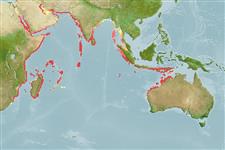Common names from other countries
>
Kurtiformes (Nurseryfishes, cardinalfishes.) >
Apogonidae (Cardinalfishes) > Apogoninae
Etymology: Cheilodipterus: Greek, cheilos = lip + Greek, di = two + Greek, pteryx = fin (Ref. 45335).
More on author: Gmelin.
Environment: milieu / climate zone / depth range / distribution range
Ökologie
seewasser riff-verbunden; tiefenbereich 3 - 25 m. Tropical; 30°N - 30°S
Western Indian Ocean: Red Sea, Tanzania, Mozambique, Seychelles, and India. Absence of the species elsewhere in the Indian Ocean, is probably due to inadequate sampling. Absence from the Gulf of Aqaba and Persian Gulf may be the result of competition with lachneri and persicus, respectively.
Size / Gewicht / Alter
Maturity: Lm ? range ? - ? cm
Max length : 18.0 cm SL Männchen/unbestimmt; (Ref. 9710); common length : 8.0 cm SL Männchen/unbestimmt; (Ref. 2935)
Color in life pale brown with 13-16 dark brown stripes. In large fish, dorsal stripes may be irregular. A small dark spot encircled by yellow area on caudal peduncle. Spot sometimes expanded to form a dark brown bar around caudal peduncle. Distinct snow white bar between dark caudal spot (or bar) and posterior ends of body stripes. First dorsal fin dusky to dark brown. Other fins pale (in young) to dusky (in adults), but never as dark as first dorsal fin. Snout somewhat darker than body (Ref 8525).
A common species found in small aggregations around corals (Ref. 9710).
Life cycle and mating behavior
Geschlechtsreife | Fortpflanzung | Ablaichen | Eier | Fecundity | Larven
Mouthbrooders (Ref. 240). Distinct pairing during courtship and spawning (Ref. 205).
Randall, J.E., 1995. Coastal fishes of Oman. University of Hawaii Press, Honolulu, Hawaii. 439 p. (Ref. 11441)
IUCN Rote Liste Status (Ref. 130435)
CITES (Ref. 128078)
Not Evaluated
Bedrohung für Menschen
Harmless
Nutzung durch Menschen
Mehr Information
ReferenzenAquakulturAquakultur ProfilZuchtlinienGenetikElectrophoresesVererbbarkeitKrankheitenVerarbeitungMass conversion
Tools
Zusatzinformationen
Download XML
Internet Quellen
Estimates based on models
Preferred temperature (Ref.
115969): 25 - 29, mean 27.8 (based on 1053 cells).
Phylogenetic diversity index (Ref.
82804): PD
50 = 0.5000 [Uniqueness, from 0.5 = low to 2.0 = high].
Bayesian length-weight: a=0.01122 (0.00528 - 0.02384), b=3.10 (2.92 - 3.28), in cm Total Length, based on LWR estimates for this (Sub)family-body shape (Ref.
93245).
Trophic level (Ref.
69278): 3.5 ±0.50 se; based on food items.
Widerstandsfähigkeit (Ref.
120179): hoch, Verdopplung der Population dauert weniger als 15 Monate. (Preliminary K or Fecundity.).
Fishing Vulnerability (Ref.
59153): Low vulnerability (12 of 100).
